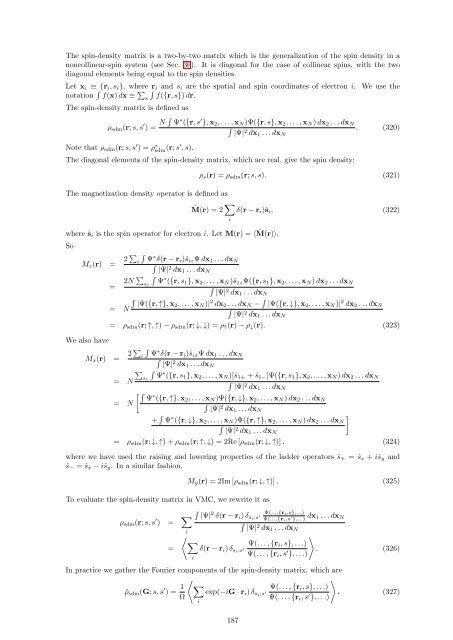CASINO manual - Theory of Condensed Matter
CASINO manual - Theory of Condensed Matter
CASINO manual - Theory of Condensed Matter
You also want an ePaper? Increase the reach of your titles
YUMPU automatically turns print PDFs into web optimized ePapers that Google loves.
The spin-density matrix is a two-by-two matrix which is the generalization <strong>of</strong> the spin density in a<br />
noncollinear-spin system (see Sec. 36). It is diagonal for the case <strong>of</strong> collinear spins, with the two<br />
diagonal elements being equal to the spin densities.<br />
Let x i ≡ {r i , s i }, where r i and s i are the spatial and spin coordinates <strong>of</strong> electron i.<br />
notation ∫ f(x) dx ≡ ∑ ∫<br />
s f({r, s}) dr.<br />
The spin-density matrix is defined as<br />
We use the<br />
ρ sdm (r; s, s ′ ) = N ∫ Ψ ∗ ({r, s ′ }, x 2 , . . . , x N )Ψ({r, s}, x 2 , . . . , x N ) dx 2 . . . dx<br />
∫ N<br />
. (320)<br />
|Ψ|2 dx 1 . . . dx N<br />
Note that ρ sdm (r; s, s ′ ) = ρ ∗ sdm (r; s′ , s).<br />
The diagonal elements <strong>of</strong> the spin-density matrix, which are real, give the spin density:<br />
The magnetization density operator is defined as<br />
ρ s (r) = ρ sdm (r; s, s). (321)<br />
ˆM(r) = 2 ∑ i<br />
δ(r − r i )ŝ i , (322)<br />
where ŝ i is the spin operator for electron i. Let M(r) = 〈 ˆM(r)〉.<br />
So<br />
M z (r) = 2 ∑ i<br />
∫<br />
Ψ ∗ δ(r − r i )ŝ iz Ψ dx 1 . . . dx N<br />
∫<br />
|Ψ|2 dx 1 . . . dx N<br />
= 2N ∑ ∫<br />
s 1 Ψ ∗ ({r, s 1 }, x 2 , . . . , x N )ŝ 1z Ψ({r, s 1 }, x 2 , . . . , x N ) dx 2 . . . dx N<br />
∫<br />
|Ψ|2 dx 1 . . . dx N<br />
∫<br />
|Ψ({r, ↑}, x2 , . . . , x N )| 2 dx 2 . . . dx N − ∫ |Ψ({r, ↓}, x 2 , . . . , x N )| 2 dx 2 . . . dx N<br />
= N<br />
∫<br />
|Ψ|2 dx 1 . . . dx N<br />
= ρ sdm (r; ↑, ↑) − ρ sdm (r; ↓, ↓) = ρ ↑ (r) − ρ ↓ (r). (323)<br />
We also have<br />
M x (r) = 2 ∑ ∫<br />
i Ψ ∗ δ(r − r i )ŝ ix Ψ dx 1 . . . dx<br />
∫ N<br />
|Ψ|2 dx 1 . . . dx N<br />
∑ ∫<br />
s<br />
= N 1 Ψ ∗ ({r, s 1 }, x 2 , . . . , x N )[ŝ 1+ + ŝ 1− ]Ψ({r, s 1 }, x 2 , . . . , x N ) dx 2 . . . dx N<br />
∫<br />
|Ψ|2 dx 1 . . . dx N<br />
[∫<br />
Ψ ∗ ({r, ↑}, x 2 , . . . , x N )Ψ({r, ↓}, x 2 , . . . , x N ) dx 2 . . . dx N<br />
= N<br />
∫<br />
|Ψ|2 dx 1 . . . dx N<br />
+ ∫ Ψ ∗ ]<br />
({r, ↓}, x 2 , . . . , x N )Ψ({r, ↑}, x 2 , . . . , x N ) dx 2 . . . dx<br />
∫ N<br />
|Ψ|2 dx 1 . . . dx N<br />
= ρ sdm (r; ↓, ↑) + ρ sdm (r; ↑, ↓) = 2Re [ρ sdm (r; ↓, ↑)] , (324)<br />
where we have used the raising and lowering properties <strong>of</strong> the ladder operators ŝ + = ŝ x + iŝ y and<br />
ŝ − = ŝ x − iŝ y . In a similar fashion,<br />
To evaluate the spin-density matrix in VMC, we rewrite it as<br />
∫<br />
|Ψ| 2 δ(r − r i ) δ si,s ′<br />
ρ sdm (r; s, s ′ ) = ∑ i<br />
〈 ∑<br />
=<br />
i<br />
M y (r) = 2Im [ρ sdm (r; ↓, ↑)] . (325)<br />
Ψ(...,{r i,s},...)<br />
Ψ(...,{r i,s ′ },...) dx 1 . . . dx N<br />
∫<br />
|Ψ|2 dx 1 . . . dx N<br />
〉<br />
Ψ(. . . , {r i , s}, . . .)<br />
δ(r − r i ) δ si,s ′ Ψ(. . . , {r i , s ′ . (326)<br />
}, . . .)<br />
In practice we gather the Fourier components <strong>of</strong> the spin-density matrix, which are<br />
〈 〉<br />
˜ρ sdm (G; s, s ′ ) = 1 ∑ Ψ(. . . , {r i , s}, . . .)<br />
exp(−iG · r i ) δ si,s<br />
Ω<br />
′ Ψ(. . . , {r<br />
i<br />
i , s ′ , (327)<br />
}, . . .)<br />
187

















